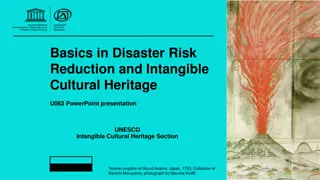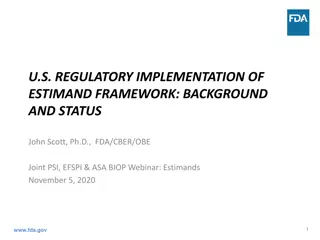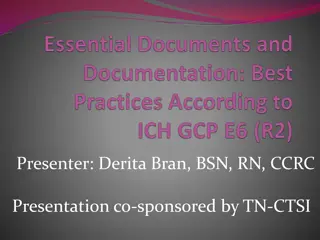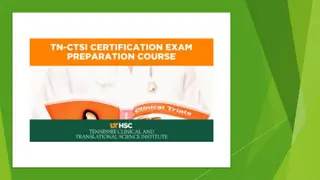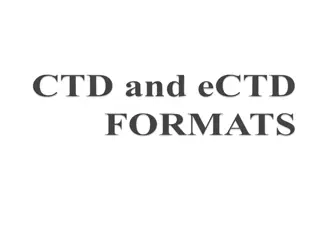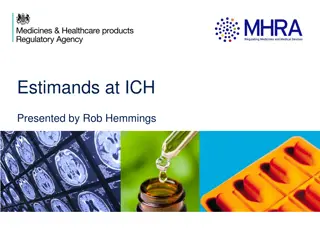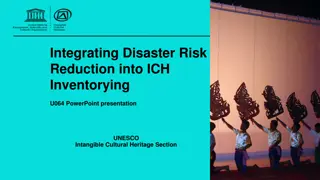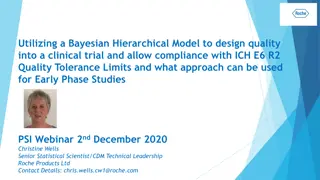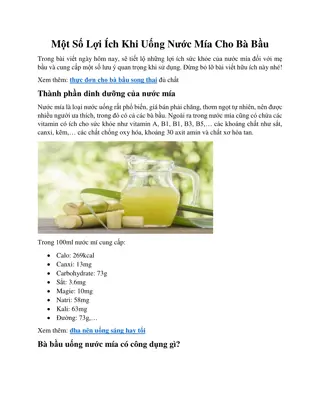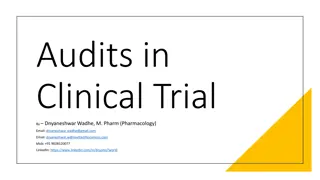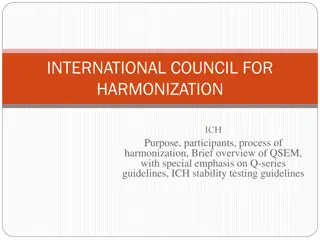
International Conference on Harmonization - Evolution and Objectives
Learn about the International Conference on Harmonization (ICH), its evolution, objectives, and the need for harmonization in pharmaceutical regulations globally. Understand how ICH guidelines contribute to ensuring the safety, quality, and efficacy of medicines for human use.
Download Presentation

Please find below an Image/Link to download the presentation.
The content on the website is provided AS IS for your information and personal use only. It may not be sold, licensed, or shared on other websites without obtaining consent from the author. If you encounter any issues during the download, it is possible that the publisher has removed the file from their server.
You are allowed to download the files provided on this website for personal or commercial use, subject to the condition that they are used lawfully. All files are the property of their respective owners.
The content on the website is provided AS IS for your information and personal use only. It may not be sold, licensed, or shared on other websites without obtaining consent from the author.
E N D
Presentation Transcript
ICH INTERNATIONAL CONFERENCE FOR HORMONIZATION Presented By K. Gayathri Devi, M. Pharm., Assistant Professor, Department Of Pharmaceutical Analysis, MAM College Of Pharmacy, Kesanupalli.
CONTENTS INTRODUCTION NEED FOR HARMONISE ORIGIN OF ICH EVOLUTION OF ICH OBJECTIVES OF ICH ICH MEMBERS PROCESS OF ICH ICH GUIDELINES Q,S,E,M
INTRODUCTION ICH stands for International Conference on Harmonization of Technical Requirements for Registration of Pharmaceuticals for Human Use . Which is international non-profit Association ,which is unique in bringing together the regulatory authorities and pharmaceutical industries. Where European Union, Japan and the USA involve in scientific and technical discussions of the testing procedures required to assess and ensure the safety, quality and efficacy of medicines. These are the three pillars on which the health of the patients depend. ICH Guidelines accepted as law in several Countries to ensure and access the Q,S,E of medicines but are only used as guidance for the U.S Food and Drug Administration. Each regulatory co-sponsor implements the guidelines according to its National or Regional requirements. They are intended to be used in combination with any regional requirements.
Need to Harmonize Many time-consuming and expensive test procedures, in order to market new products, internationally. Over rising costs of health care making safe and efficacious new treatments available to patients in need. Divergence in technical requirements from country to country.
ORIGIN OF ICH Harmonization of regulatory requirements was pioneered by the EU, Europe, in the 1980s as the Europe move towards the development of single market. The success achieved in Europe demonstrated that harmonization was feasible. At the same time there were discussions between Europe, Japan and the US on possibilities for harmonization. The birth of ICH took place at a meeting in April 1990. Topics selected for harmonization would be divided into safety ,quality and efficacy to reflect the three criteria which are the basis for approving and authorizing new medicinal products.
EVOLUTION OF ICH First decade : significant progress in the development of ICH Guidelines on Safety ,Quality and Efficacy topics and also work on a number of important multidisciplinary topics. Second decade: implementation of ICH Guidelines in the ICH regions. Expand communication and information on ICH Guidelines with other regions. Third decade : extending the benefits of harmonization beyond the ICH regions. Training ,as well as active participation of other regions in Guideline development is seen as key in this effort.
OBJECTIVES OF ICH Promote public health by early availability of drug in the market. Maintaining safeguards on quality, safety and efficacy. Improve efficiency of new drug development ,Reduce registration cost. Less expensive drugs for patients. Prevent the duplication of clinical trails in humans. Minimize the animal use with out compromising in safety ,efficacy of the product. Mutual acceptance of clinical data by regulatory authority. Reducing testing duplication.
ICH MEMBERS EU EFPIA associations). MHLW (Ministry of health, Labour and welfare, Japan). JPMA (Japan Pharmaceuticals manufacturers Association). US FDA. PhRMA(pharmaceutical research and manufacturers association). Observers : WHO, TPP(Canada). International federation of Pharmaceutical manufacturer s association. (European federation of pharmaceutical industries
ICH GUIDELINES The guidelines of ICH are broadly categorized into four types. 1) Quality guidelines. 2) Safety guidelines. 3) Efficacy guidelines. 4) Multidisciplinary guidelines.
QUALITY: Harmonization achievements in the Quality area include such as the conduct of stability studies, defining relevant thresholds for impurities testing and a more flexible approach to pharmaceutical quality based on Good Manufacturing Practice (GMP) risk management. SAFETY : ICH has produced a comprehensive set of safety Guidelines to potential risks like carcinogenicity, Geno toxicity and nephrotoxicity etc., EFFICACY : The work carried out by ICH under the Efficacy heading is concerned with the design, conduct, safety and reporting of clinical trials. It also covers novel types of medicines derived from biotechnological processes and the use of pharmacogenomics / genomics techniques to produce better targeted medicines. MULTIDISCPLINARY : These are the cross-cutting topics which do not fit uniquely into one of the Quality, Safety and Efficacy categories. It includes the ICH medical terminology (Med DRA), the Common Technical Document (CTD) and the development of Electronic Standards for the Transfer of Regulatory Information (ESTRI).
QUALITY GUIDELINES Q1A - Q1F :Stability Q2 : Analytical Validation Q3A - Q3D : Impurities Q4 - Q4B : Pharmacopoeias Q5A - Q5E : Quality of Biotechnological Products Q6A- Q6B : Specifications Q7 : Good Manufacturing Practice Q8 : Pharmaceutical Development Q9 : Quality Risk Management Q10 : Pharmaceutical Quality System Q11 : Development and Manufacture of Drug Substances Q12 : Lifecycle Management Q13 : Continuous Manufacturing of Drug Substances and Drug Products Q14 : Analytical Procedure Development
SAFETY GUIDELINES S1A - S1C : Carcinogenicity Studies S2 : Geno toxicity Studies S3A - S3B : Toxic kinetics and Pharmacokinetics S4 : Toxicity Testing S5 : Reproductive Toxicology S6 : Biotechnological Products S7A - S7B : Pharmacology Studies S8 : Immune toxicology Studies S9 : Nonclinical Evaluation for Anticancer Pharmaceuticals S10 : Photo safety Evaluation S11 : Nonclinical Paediatric Safety
EFFICACY GUIDELINES E1 : Clinical Safety for Drugs used in Long-Term Treatment E2A - E2F : Pharmacovigilance. E3 : Clinical Study Reports E4 : Dose-Response Studies E5 : Ethnic Factors E6 : Good Clinical Practice E7 :Clinical Trials in Geriatric Population E8 : General Considerations for Clinical Trials E9 :Statistical Principles for Clinical Trials E10 : Choice of Control Group in Clinical Trials E11 - E11A : Clinical Trials in Paediatric Population E12 :Clinical Evaluation by Therapeutic Category E14 :Clinical Evaluation of QT E15 :Definitions in Pharmacogenomics E17 : Multi-Regional Clinical Trials E18 : Genomic Sampling
MULTIDISCIPLINARY GUIDELINES M1 : Med DRA Terminology M2 : Electronic Standards M3 : Nonclinical Safety Studies M4 : Common Technical Document . M5 : Data Elements and Standards for Drug Dictionaries M6 : Gene Therapy M7 : Mutagenic impurities M8 : Electronic Common Technical Document (eCTD) M9 : Biopharmaceutics Classification System-based Bio waivers M10 : Bioanalytical Method Validation


